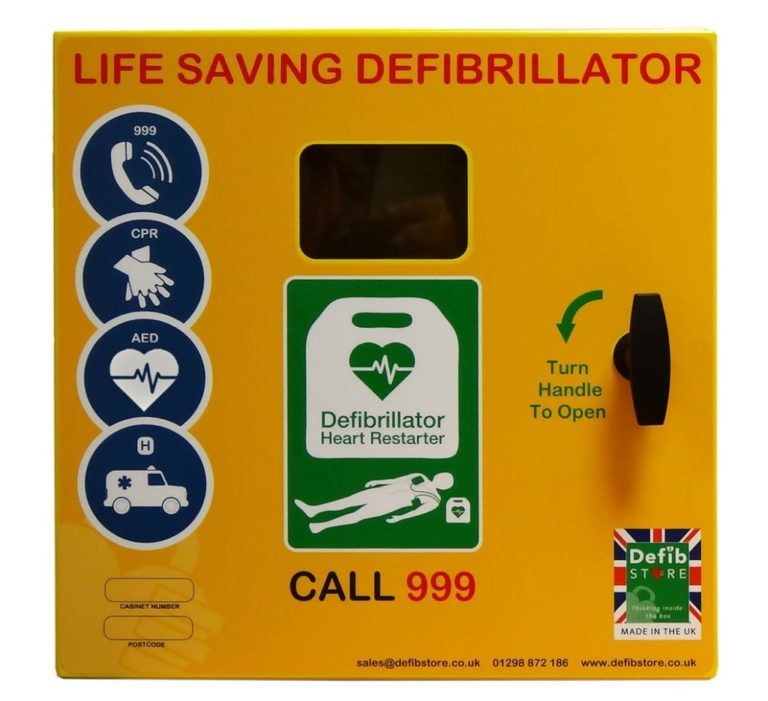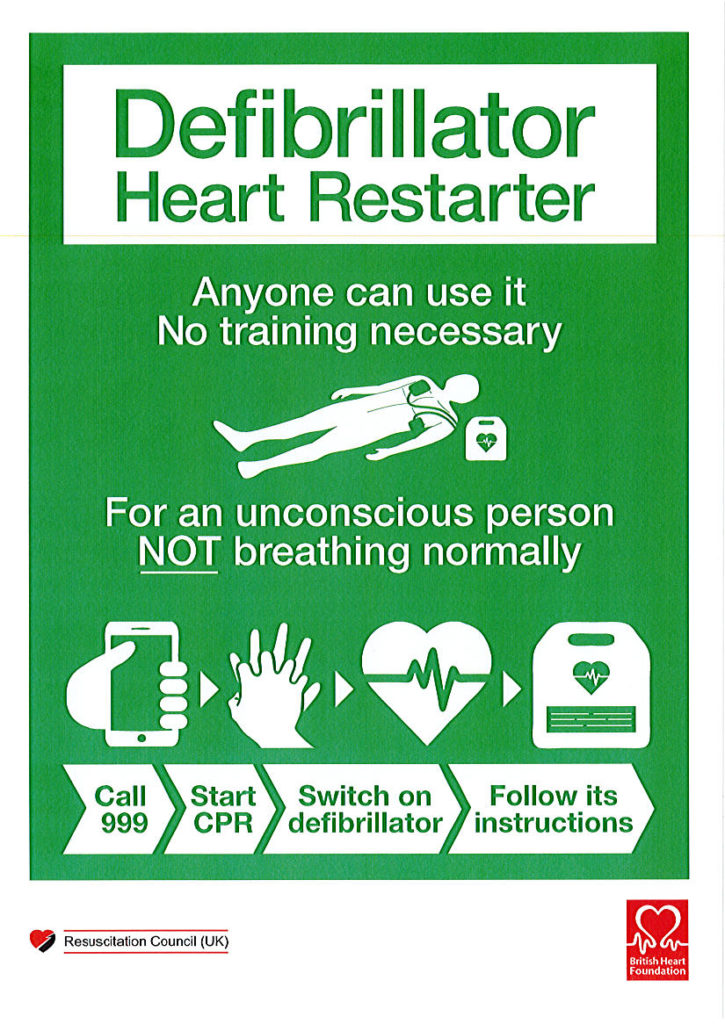We were successful in receiving a grant from the British Heart Foundation, as well as receiving kind donations from our Parishioners to purchase a ‘ Public Access defibrillator’ which is now kept in a cabinet in the exterior alcove, near to our notice board at St Joseph and the English Martyrs Catholic Church. It has been security marked and is accessible 24/7.
We hope to run regular sessions in the Windhill Churches Centre and train as many people as possible in CPR and how to perform it should the situation ever arise.
The next Training sessions is to be advised. There will be a sign up sheet in the Sacristy and spaces for 10 people at a time. The session will take 1 1/2 hours.
Total Number of Parishioners trained to date – 33 and counting …
On Wednesday 18th June 2020 our defibrillator was used to help save the life of a passer by who had collapsed outside of the Church by 2 workmen ( from the Church) and a couple who were working on a house opposite. They did a fantastic job before the paramedics and air ambulance arrived on scene. We are keeping the lady and her family very much in our thoughts and prayers. It is so important to know what to do .. so, please sign up to our next course or watch the videos below. The worst thing that you can do is .. nothing.
On Friday 19th June we received an email..
To everyone at the Church,
This post comes with the upmost thanks from everyone in my family. My mum, Jeanette collapsed outside on Wednesday and without the intervention from passers by and the defibrillator we would very much be in a different situation. Mum is still in a very critical condition but stable in intensive care. She has shown signs of coming round so hoping in the next few days she will be waken but we have still a long way to go.
Please keep us in your prayers.
6/7/2020
Thought I would just inform you that mum is going from strength to strength. On Friday she had an electronic pacemaker implanted under the skin and has been told that hopefully Monday or Tuesday she can come home after 3 weeks in hospital. We are just so happy with her recovery and once again continue to thank everyone that was there to help on that day.
We will be forever thankful x
If you are unable to attend any of the training sessions, below is some information courtesy of the British Heart Foundation web site on how to perform CPR and how use a defibrillator. Please take a few minutes to familiarise yourself, your family members and friends – it is very easy. The defibrillator itself gives clear spoken instructions – all you have to do is follow them – and it won’t shock someone unless they need it!
INSTRUCTIONS
If you come across someone who is unconscious, unresponsive, not breathing or not breathing normally, they’re in cardiac arrest. The most important thing is to call 999 and start CPR to keep the blood flowing to the brain and around the body. After a cardiac arrest, every minute without CPR and defibrillation reduces someone’s chance of survival by 10 per cent.
If you’re on your own, don’t interrupt the CPR to go and get a defibrillator. If it’s possible, send someone else to find one. When you call 999, the operator can tell you if there’s a public access defibrillator nearby.
Due to the current corona virus outbreak, there are several important changes to CPR that the Resuscitation council UK advise. If you find someone unconscious follow these simple steps. Information correct as of 3/6/2020
To learn how to perform CPR, follow these simple steps:
- Step 1: Shake and shout for help.
- Step 2: Call 999.
- Step 3: Do not put your face close to theirs. Use a towel or a piece of clothing and lay it over their mouth and nose.
- Step 4: Give chest compressions.
- Step 5: Continue until an ambulance arrives.
CPR steps
To learn more about performing CPR in an emergency, read the rest of this page and scroll down for our CPR training video.
Step 1: Shake and shout
Someone having a cardiac arrest will either not be breathing or they won’t be breathing normally. They also won’t be conscious.
If you come across someone who is unconscious, always check for danger and look for risks before you start helping.
Check for a response – gently shake the person’s shoulders and ask loudly ‘are you alright?’
Shout for help – if someone is nearby, ask them to stay as you might need them. If you are alone, shout loudly to attract attention, but don’t leave the person.
Step 2: Call 999
If the person is not breathing or not breathing normally:
- ask someone to call 999 immediately and ask for an ambulance
- ask someone for a public access defibrillator (PAD).
If there’s no one around call 999 before starting compressions.
Step 3: Cover mouth and nose with cloth.
- Using a towel or a piece of clothing, lay it over the mouth and nose but do not put your face close to theirs.
- If you’re sure the person is breathing normally, then put them in the recovery position.
Step 4: Give chest compressions
Do not give rescue breaths at this time.
- Kneel next to the person.
- Place the heel of one hand in the centre of their chest. Place your other hand on top of the first. Interlock your fingers.
- With straight arms, use the heel of your hand to push the breastbone down firmly and smoothly, so that the chest is pressed down between 5–6 cm, and release.
- Do this at a rate of 100 to 120 chest compressions per minute – that’s around 2 per second.
Step 5: Keep going
- Keep going until professional help arrives and takes over, or the person starts to show signs of regaining consciousness, such as coughing, opening their eyes, speaking, or breathing normally.
- If you’re feeling tired, and there’s someone nearby to help, instruct them to continue.
Keep going until professional help arrives and takes over, or the person starts to show signs of regaining consciousness, such as coughing, opening their eyes, speaking, or breathing normally.
If you’re feeling tired, and there’s someone nearby to help, instruct them to continue.
How to do Hands-only CPR
When somebody collapses in front of you, what do you do?
- Check the person over. If they are not responsive and not breathing normally, then their heart has stopped working and they are having a cardiac arrest.
- Now, call 999.
- Using a towel or a piece of clothing, lay it over the mouth and nose but do not put your face close to theirs.
- Then you do Hands-only CPR.
- Put one hand on top of the other, interlinking your fingers. Your hand on the bottom should have the fingers open. Lock your fingers together, knuckles up. Then push down, in the middle of the chest right on the sovereign. Push down five or six centimetres. That’s about two inches. Push hard and fast about two times a second, like to the beat of Stayin’ Alive. Don’t worry about hurting someone. A cracked rib can be mended –just concentrate on saving a life.
- Keep this up until the ambulance arrives.
So don’t forget. Check him over. Call 999. Push hard and fast to Stayin’ Alive. It works.
Hands-only CPR. It’s not as hard as it looks.
Please be aware that rescue breaths are not advised during the coronavirus pandemic.
British Heart Foundation CPR demonstration video
DOWNLOAD AND PRINT OFF THIS HANDY BHF FIRST AID REMINDER CARD – Click on the link below
To use a defibrillator, follow these simple steps:
Step 1: Turn the defibrillator on by pressing the green button and follow its instructions.
Step 2: Peel off the sticky pads and attach them to the patient’s skin, one on each side of the chest, as shown in the picture on the defibrillator.
Step 3: Once the pads have been attached, stop CPR and don’t touch the patient. The defibrillator will then analyse the patient’s heart rhythm.
Step 4: The defibrillator will assess whether a shock is needed and if so, it will tell you to press the shock button. An automatic defibrillator will shock the patient without prompt. Do not touch the patient while they are being shocked.
Step 5: The defibrillator will tell you when the shock has been delivered and whether you need to continue CPR.
Step 6: Continue with chest compressions and rescue breaths until the patient shows signs of life or the defibrillator tells you to stop so it can analyse the heartbeat again.
British Heart Foundation – How to use a defibrillator demonstration Video

